《DSP using MATLAB》Problem 8.40

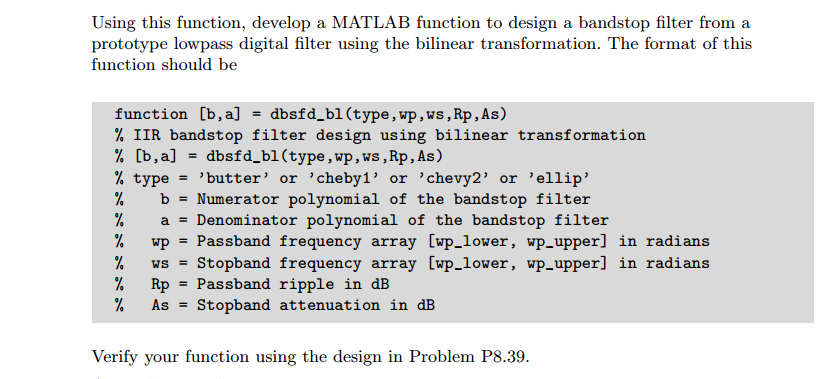

代码:
function [wpLP, wsLP, alpha] = bs2lpfre(wpbs, wsbs)
% Band-edge frequency conversion from bandstop to lowpass digital filter
% -------------------------------------------------------------------------
% [wpLP, wsLP, alpha] = bs2lpfre(wpbs, wsbs)
% wpLP = passband edge for the lowpass digital prototype
% wsLP = stopband edge for the lowpass digital prototype
% alpha = lowpass to bandstop transformation parameter
% wpbs = passband edge frequency array [wp_lower, wp_upper] for the bandstop
% wsbs = stopband edge frequency array [ws_lower, ws_upper] for the bandstop
%
% % Determine the digital lowpass cutoff frequencies:
wpLP = 0.2*pi;
K = tan((wpbs(2)-wpbs(1))/2)*tan(wpLP/2);
beta = cos((wpbs(2)+wpbs(1))/2)/cos((wpbs(2)-wpbs(1))/2);
alpha1 = -2*beta*K/(K+1);
alpha2 = (1-K)/(K+1); alpha = [alpha1, alpha2]; wsLP = -angle((exp(-2*j*wsbs(1))+alpha1*exp(-j*wsbs(1))+alpha2)/(alpha2*exp(-2*j*wsbs(1))+alpha1*exp(-j*wsbs(1))+1))
wsLP = angle((exp(-2*j*wsbs(2))+alpha1*exp(-j*wsbs(2))+alpha2)/(alpha2*exp(-2*j*wsbs(2))+alpha1*exp(-j*wsbs(2))+1))
function [b, a] = cheb1bsf(wpbs, wsbs, Rp, As)
% IIR bandstop Filter Design using Chebyshev-1 Prototype
% -----------------------------------------------------------------------
% [b, a] = cheb1bsf(wp, ws, Rp, As);
% b = numerator polynomial coefficients of bandstop filter, Direct form
% a = denominator polynomial coefficients of bandstop filter, Direct form
% wp = Passband edge frequency array [wp_lower, wp_upper] in radians;
% ws = Stopband edge frequency array [ws_lower, ws_upper] in radians;
% Rp = Passband ripple in +dB; Rp > 0
% As = Stopband attenuation in +dB; As > 0
%
%
% Determine the digital lowpass cutoff frequencies:
wpLP = 0.2*pi;
K = tan((wpbs(2)-wpbs(1))/2)*tan(wpLP/2);
beta = cos((wpbs(2)+wpbs(1))/2)/cos((wpbs(2)-wpbs(1))/2);
alpha1 = -2*beta*K/(K+1);
alpha2 = (1-K)/(K+1); alpha = [alpha1, alpha2]; wsLP = -angle((exp(-2*j*wsbs(1))+alpha1*exp(-j*wsbs(1))+alpha2)/(alpha2*exp(-2*j*wsbs(1))+alpha1*exp(-j*wsbs(1))+1))
wsLP = angle((exp(-2*j*wsbs(2))+alpha1*exp(-j*wsbs(2))+alpha2)/(alpha2*exp(-2*j*wsbs(2))+alpha1*exp(-j*wsbs(2))+1)) % Compute Analog Lowpass Prototype Specifications: Inverse Mapping for frequencies
T = 1; Fs = 1/T; % set T = 1
OmegaP = (2/T)*tan(wpLP/2); % Prewarp(Cutoff) prototype passband freq
OmegaS = (2/T)*tan(wsLP/2); % Prewarp(cutoff) prototype stopband freq % Design Analog Chebyshev-1 Prototype Lowpass Filter:
[cs, ds] = afd_chb1(OmegaP, OmegaS, Rp, As); % Bilinear transformation to obtain digital lowpass:
[blp, alp] = bilinear(cs, ds, Fs); % Transform digital lowpass into bandstop filter
Nz = [alpha2, alpha1, 1]; Dz = [1, alpha1, alpha2];
[b, a] = zmapping(blp, alp, Nz, Dz);
%% ------------------------------------------------------------------------
%% Output Info about this m-file
fprintf('\n***********************************************************\n');
fprintf(' <DSP using MATLAB> Problem 8.40.2 \n\n'); banner();
%% ------------------------------------------------------------------------ % Digital Filter Specifications: Chebyshev-1 bandstop
wsbs = [0.35*pi 0.65*pi]; % digital stopband freq in rad
wpbs = [0.25*pi 0.75*pi]; % digital passband freq in rad delta1 = 0.05; % passband tolerance, absolute specs
delta2 = 0.01; % stopband tolerance, absolute specs Rp = -20 * log10( (1-delta1)/(1+delta1)) % passband ripple in dB
As = -20 * log10( delta2 / (1+delta1)) % stopband attenuation in dB Ripple = 10 ^ (-Rp/20) % passband ripple in absolute
Attn = 10 ^ (-As/20) % stopband attenuation in absolute % --------------------------------------------------------
% method 1: cheb1bsf function
% --------------------------------------------------------
fprintf('\n*******Digital bandstop, Coefficients of DIRECT-form***********\n');
[bbs, abs] = cheb1bsf(wpbs, wsbs, Rp, As)
[C, B, A] = dir2cas(bbs, abs) % Calculation of Frequency Response: [dbbs, magbs, phabs, grdbs, wwbs] = freqz_m(bbs, abs); % ---------------------------------------------------------------
% find Actual Passband Ripple and Min Stopband attenuation
% ---------------------------------------------------------------
delta_w = 2*pi/1000;
Rp_bs = -(min(dbbs( 1:1:ceil(wpbs(1)/delta_w+1) ))); % Actual Passband Ripple fprintf('\nActual Passband Ripple is %.4f dB.\n', Rp_bs); As_bs = -round(max(dbbs(ceil(wsbs(1)/delta_w)+1:1:ceil(wsbs(2)/delta_w)+1))); % Min Stopband attenuation
fprintf('\nMin Stopband attenuation is %.4f dB.\n\n', As_bs); %% -----------------------------------------------------------------
%% Plot
%% ----------------------------------------------------------------- figure('NumberTitle', 'off', 'Name', 'Problem 8.40.2 Chebyshev-1 bs by cheb1bsf function')
set(gcf,'Color','white');
M = 1; % Omega max subplot(2,2,1); plot(wwbs/pi, magbs); axis([0, M, 0, 1.2]); grid on;
xlabel('Digital frequency in \pi units'); ylabel('|H|'); title('Magnitude Response');
set(gca, 'XTickMode', 'manual', 'XTick', [0, 0.25, 0.35, 0.65, 0.75, M]);
set(gca, 'YTickMode', 'manual', 'YTick', [0, 0.01, 0.9048, 1]); subplot(2,2,2); plot(wwbs/pi, dbbs); axis([0, M, -100, 2]); grid on;
xlabel('Digital frequency in \pi units'); ylabel('Decibels'); title('Magnitude in dB');
set(gca, 'XTickMode', 'manual', 'XTick', [0, 0.25, 0.35, 0.65, 0.75, M]);
set(gca, 'YTickMode', 'manual', 'YTick', [-80, -44, -1, 0]);
set(gca,'YTickLabelMode','manual','YTickLabel',['80'; '44';'1 ';' 0']); subplot(2,2,3); plot(wwbs/pi, phabs/pi); axis([0, M, -1.1, 1.1]); grid on;
xlabel('Digital frequency in \pi nuits'); ylabel('radians in \pi units'); title('Phase Response');
set(gca, 'XTickMode', 'manual', 'XTick', [0, 0.25, 0.35, 0.65, 0.75, M]);
set(gca, 'YTickMode', 'manual', 'YTick', [-1:0.5:1]); subplot(2,2,4); plot(wwbs/pi, grdbs); axis([0, M, 0, 30]); grid on;
xlabel('Digital frequency in \pi units'); ylabel('Samples'); title('Group Delay');
set(gca, 'XTickMode', 'manual', 'XTick', [0, 0.25, 0.35, 0.65, 0.75, M]);
set(gca, 'YTickMode', 'manual', 'YTick', [0:10:30]); figure('NumberTitle', 'off', 'Name', 'Problem 8.40.2 Pole-Zero Plot')
set(gcf,'Color','white');
zplane(bbs, abs);
title(sprintf('Pole-Zero Plot'));
%pzplotz(b,a); % --------------------------------------------------------------------------------
% cheby1 function
% --------------------------------------------------------------------------------
% Calculation of Chebyshev-1 filter parameters:
[N, wn] = cheb1ord(wpbs/pi, wsbs/pi, Rp, As); fprintf('\n ********* Chebyshev-1 Digital Bandstop Filter Order is = %3.0f \n', 2*N) % Digital Chebyshev-1 bandstop Filter Design:
[bbs, abs] = cheby1(N, Rp, wn, 'stop'); [C, B, A] = dir2cas(bbs, abs) % Calculation of Frequency Response:
[dbbs, magbs, phabs, grdbs, wwbs] = freqz_m(bbs, abs); % ---------------------------------------------------------------
% find Actual Passband Ripple and Min Stopband attenuation
% ---------------------------------------------------------------
delta_w = 2*pi/1000;
Rp_bs = -(min(dbbs(1:1:ceil(wpbs(1)/delta_w+1)))); % Actual Passband Ripple fprintf('\nActual Passband Ripple is %.4f dB.\n', Rp_bs); As_bs = -round(max(dbbs(ceil(wsbs(1)/delta_w)+1:1:ceil(wsbs(2)/delta_w)+1))); % Min Stopband attenuation
fprintf('\nMin Stopband attenuation is %.4f dB.\n\n', As_bs); %% -----------------------------------------------------------------
%% Plot
%% ----------------------------------------------------------------- figure('NumberTitle', 'off', 'Name', 'Problem 8.40.2 Chebyshev-1 bs by cheby1 function')
set(gcf,'Color','white');
M = 1; % Omega max subplot(2,2,1); plot(wwbs/pi, magbs); axis([0, M, 0, 1.2]); grid on;
xlabel('Digital frequency in \pi units'); ylabel('|H|'); title('Magnitude Response');
set(gca, 'XTickMode', 'manual', 'XTick', [0, 0.25, 0.35, 0.65, 0.75, M]);
set(gca, 'YTickMode', 'manual', 'YTick', [0, 0.01, 0.9048, 1]); subplot(2,2,2); plot(wwbs/pi, dbbs); axis([0, M, -120, 2]); grid on;
xlabel('Digital frequency in \pi units'); ylabel('Decibels'); title('Magnitude in dB');
set(gca, 'XTickMode', 'manual', 'XTick', [0, 0.25, 0.35, 0.65, 0.75, M]);
set(gca, 'YTickMode', 'manual', 'YTick', [-80, -44, -1, 0]);
set(gca,'YTickLabelMode','manual','YTickLabel',['80'; '44';'1 ';' 0']); subplot(2,2,3); plot(wwbs/pi, phabs/pi); axis([0, M, -1.1, 1.1]); grid on;
xlabel('Digital frequency in \pi nuits'); ylabel('radians in \pi units'); title('Phase Response');
set(gca, 'XTickMode', 'manual', 'XTick', [0, 0.25, 0.35, 0.65, 0.75, M]);
set(gca, 'YTickMode', 'manual', 'YTick', [-1:0.5:1]); subplot(2,2,4); plot(wwbs/pi, grdbs); axis([0, M, 0, 30]); grid on;
xlabel('Digital frequency in \pi units'); ylabel('Samples'); title('Group Delay');
set(gca, 'XTickMode', 'manual', 'XTick', [0, 0.25, 0.35, 0.65, 0.75, M]);
set(gca, 'YTickMode', 'manual', 'YTick', [0:10:30]);
运行结果:
通带、阻带设计指标,dB单位和绝对值单位
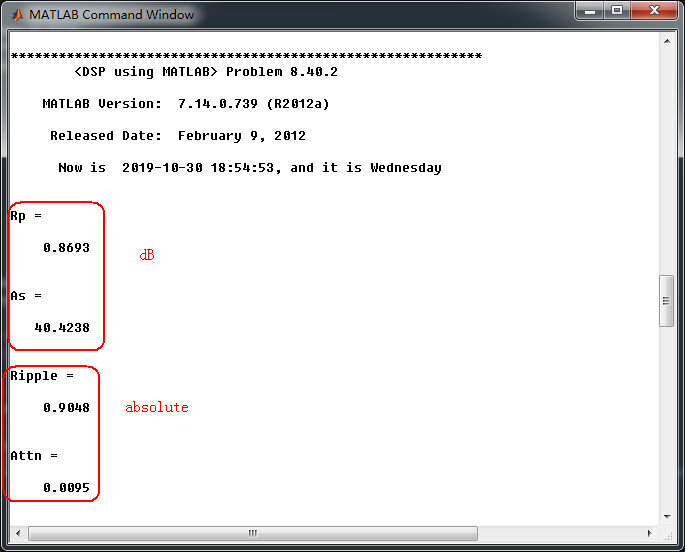
采用cheb1bsf函数,得到Chebyshev-1型数字带阻滤波器,系统函数直接形式的系数如下
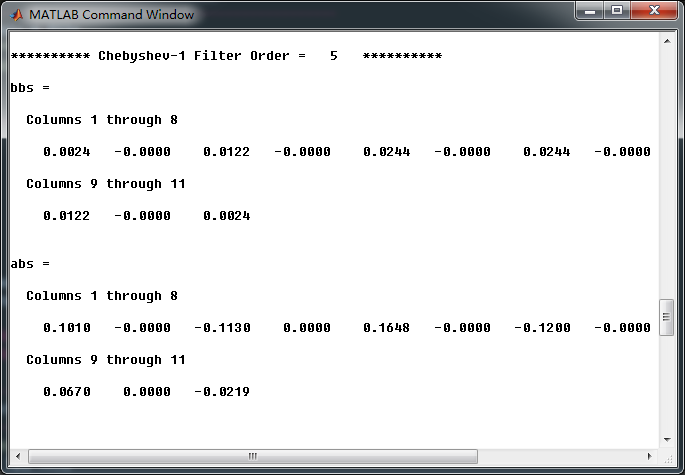
转换成串联形式,系数如下
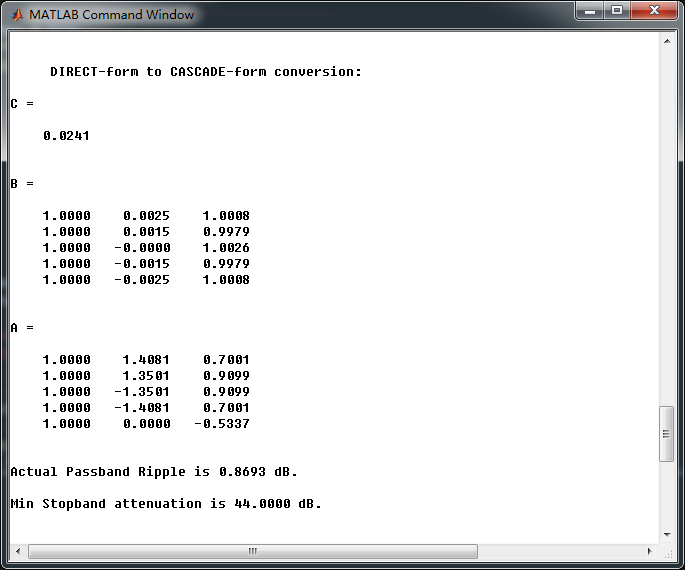
幅度谱、相位谱和群延迟响应
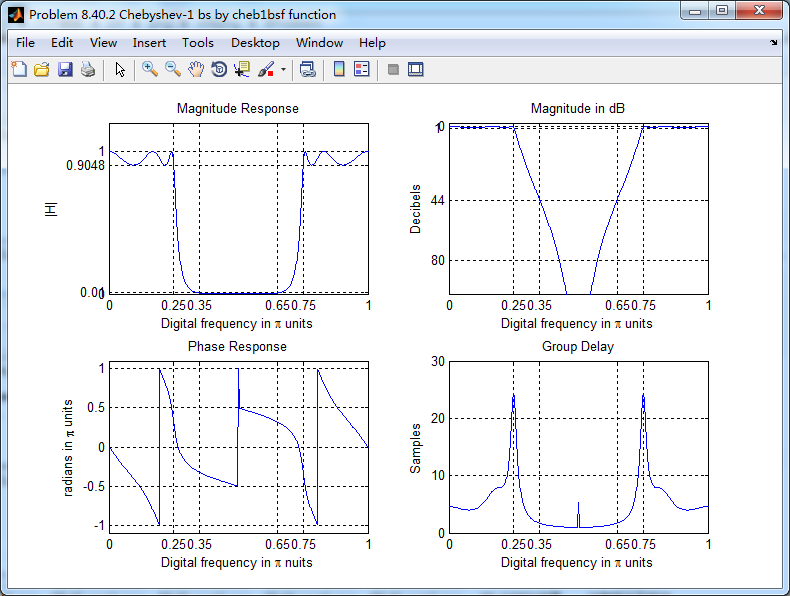
数字带阻滤波器零极点图
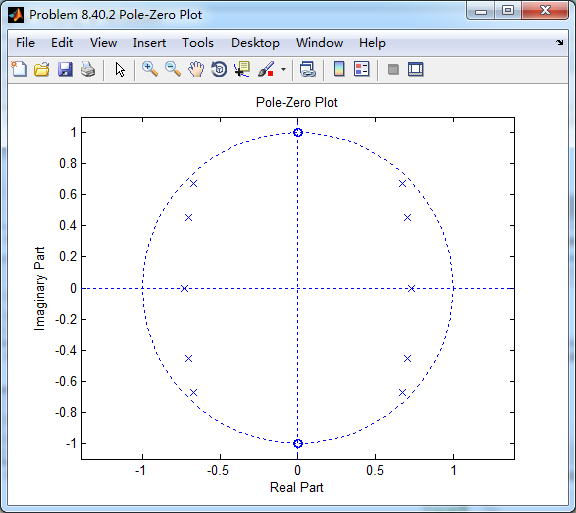
和P8.39进行对比,采用cheby1函数(MATLAB工具箱函数),计算得到数字带阻滤波器,系统函数直接形式的系数如下
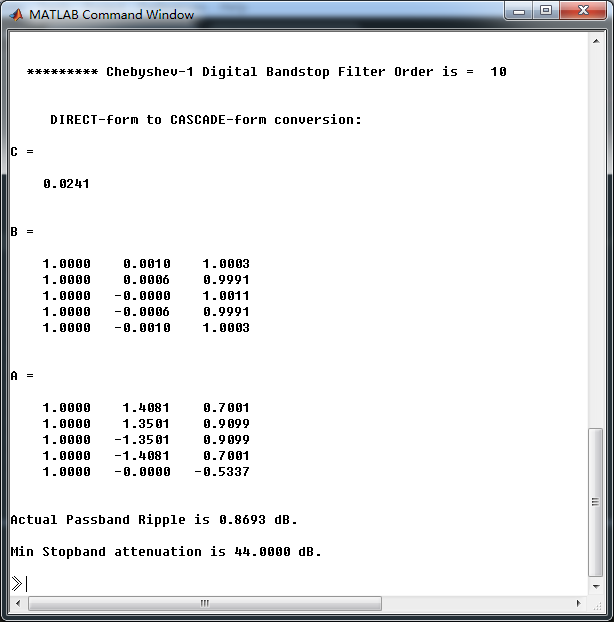
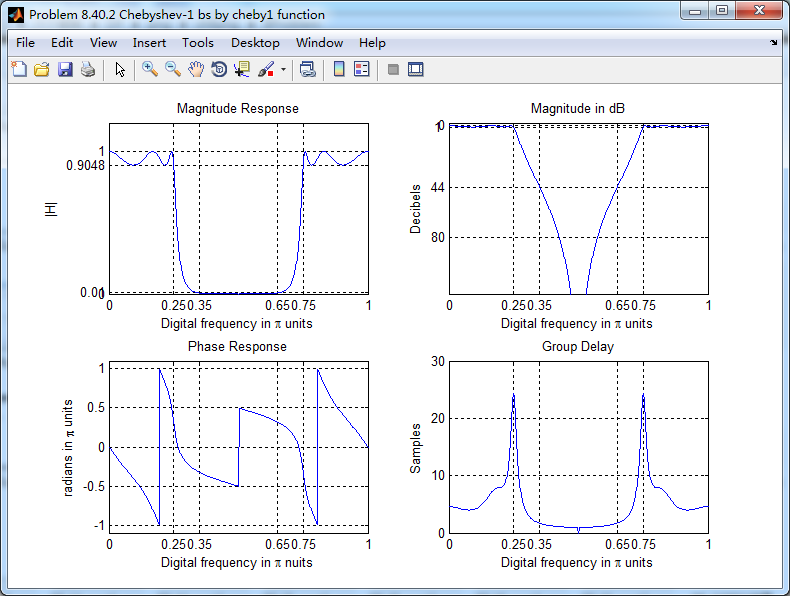
《DSP using MATLAB》Problem 8.40的更多相关文章
- 《DSP using MATLAB》Problem 7.27
代码: %% ++++++++++++++++++++++++++++++++++++++++++++++++++++++++++++++++++++++++++++++++ %% Output In ...
- 《DSP using MATLAB》Problem 7.23
%% ++++++++++++++++++++++++++++++++++++++++++++++++++++++++++++++++++++++++++++++++ %% Output Info a ...
- 《DSP using MATLAB》Problem 7.16
使用一种固定窗函数法设计带通滤波器. 代码: %% ++++++++++++++++++++++++++++++++++++++++++++++++++++++++++++++++++++++++++ ...
- 《DSP using MATLAB》Problem 7.9
代码: %% ++++++++++++++++++++++++++++++++++++++++++++++++++++++++++++++++++++++++++++++++ %% Output In ...
- 《DSP using MATLAB》Problem 7.6
代码: 子函数ampl_res function [Hr,w,P,L] = ampl_res(h); % % function [Hr,w,P,L] = Ampl_res(h) % Computes ...
- 《DSP using MATLAB》Problem 5.38
代码: %% ++++++++++++++++++++++++++++++++++++++++++++++++++++++++++++++++++++++++++++++++ %% Output In ...
- 《DSP using MATLAB》Problem 5.19
代码: function [X1k, X2k] = real2dft(x1, x2, N) %% --------------------------------------------------- ...
- 《DSP using MATLAB》Problem 5.10
代码: 第1小题: %% ++++++++++++++++++++++++++++++++++++++++++++++++++++++++++++++++++++++++++++++++ %% Out ...
- 《DSP using MATLAB》Problem 5.5
代码: %% ++++++++++++++++++++++++++++++++++++++++++++++++++++++++++++++++++++++++++++++++ %% Output In ...
随机推荐
- jq-在线引入
<script src="http://libs.baidu.com/jquery/2.0.0/jquery.min.js"></script><sc ...
- vscode编程nodejs初始安装
nodejs官网 http://nodejs.cn/ 1.安装nodejs,记得安装时勾选配置路径 在cmd中输入node,进去node环境即为安装成功. 2.安装vscode,并安装插件node e ...
- JavaScript ---- 闭包(什么是闭包,为什么使用闭包,闭包的作用)
经常被问到什么是闭包? 说实话闭包这个概念很难解释.JavaScript权威指南里有这么一段话:“JavaScript函数是将要执行的代码以及执行这些代码作用域构成的一个综合体.在计算机学术语里,这种 ...
- Ruby 命令行选项
Ruby 命令行选项 Ruby 一般是从命令行运行,方式如下: $ ruby [ options ] [.] [ programfile ] [ arguments ... ] 解释器可以通过下列选项 ...
- vue.js 2.0 --- 安装node环境,webpack和脚手架(入门篇)
1.环境搭建 1.1.安装node.js 1.2 安装过程很简单,一路“下一步”就可以了.安装完成之后,打开命令行工具(win+r,然后输入cmd),输入 node -v,如下图,如果出现相应的版本号 ...
- NX二次开发-设置尺寸的附加尺寸UF_DRF_set_appended_text
#include <uf.h> #include <uf_drf.h> #include <uf_obj.h> #include <uf_part.h> ...
- hdu多校第一场1004(hdu6581)Vacation 签到
题意:有n+1辆车,每辆车都有一定的长度,速度和距离终点的距离,第1-n辆车在前面依次排列,第0辆车在最后面.不允许超车,一旦后车追上前车,后车就减速,求第0辆车最快什么时候能到达终点? 思路:对于每 ...
- Openstack Nova 源码分析 — 使用 VCDriver 创建 VMware Instance
目录 目录 前言 流程图 nova-compute vCenter 前言 在上一篇Openstack Nova 源码分析 - Create instances (nova-conductor阶段)中, ...
- Python3 From Zero——{最初的意识:000~Initial consciousness}
http://www.liaoxuefeng.com/wiki/0014316089557264a6b348958f449949df42a6d3a2e542c000 a.编码 默认情况下,Python ...
- C盘清理垃圾
经常清理C盘垃圾,会让系统运行更快,避免死机,今天教大家一种简单实用的方法,用文本文档清理垃圾: 1:在电脑桌面空白处右键-建立文本文档: 2:把以下代码复制到文本里 @echo offecho 正在 ...
